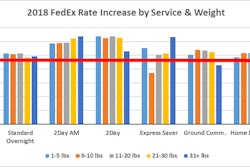
FedEx recently announced that even more packages will qualify for its dimensional pricing structure. With the holiday shopping season just around the corner, online retailers are already up against intense operational pressures. Now, many are struggling to determine how to respond to the new pricing standard.
The big question on everyone’s minds: Is there anything e-commerce brands can do to reduce the impact of dimensional pricing on shipping costs?
The New FedEx Dimensional Pricing Standard
In September, FedEx announced that the divisor it uses to calculate dimensional pricing for domestic air and ground will change January 2, 2017, driving up rates for shippers of smaller parcels.
Dimensional weight is determined by multiplying the parcel’s length (L), width (W) and height (H) in inches, and dividing the product by a divisor. The shipping rate is then calculated according to the greater of the parcel’s dimensional weight (rounded up) or actual weight.
L x W x H
DIVISOR
Under the current dimensional pricing plan, the divisor is set at 166. The new dimensional pricing standard will reduce the divisor to 139, bringing domestic shipping rates in line with international rates.
A parcel that measures a cubic foot (1,728 inches) has a dimensional weight of 11 pounds. The same parcel has a dimensional weight of 13 pounds under the new dimensional pricing standard—an increase of 18 percent.
As in the past, FedEx’s dimensional pricing change is expected to have the most significant impact on online apparel brands and merchants that specialize in small parcels. For example, even though a package containing two pairs of jeans may only weigh 2 pounds, shippers could be forced to pay for a dimensional weight of 13 pounds or more, depending on the size of the box.
Advice for Online Retailers
At Dotcom Distribution, we have firsthand experience with dimensional pricing and we understand the impact even small changes can have on a retailer’s ability to compete effectively.
The FedEx dimensional weight standard is changing, but there are several things you can do to mitigate the impact of new pricing on your e-commerce operation:
1. Evaluate Your Current Packaging Practices
Examine your products and packaging practices to identify the items that will be affected by the change. With a few adjustments, you may be able to reduce the size of the box to lower the dimensional weight or ship irregularly shaped objects in poly bags (rather than boxes) to minimize empty space.
2. Prioritize the Customer Experience
It’s tempting to start shipping products in the smallest possible boxes to achieve cost efficiencies. Resist the urge and remember the importance of the customer experience. Although it’s important to evaluate your brand’s packaging standards for opportunities to reduce costs, it’s equally important to maintain an exceptional unboxing experience and offer aesthetically pleasing product packaging.
3. Consider Alternative Shipping Options
Now is the time to explore alternative shipping options. Work with an experienced third-party logistics (3PL) provider to take advantage of the 3PL’s bulk shipping rates and existing relationship with FedEx. The best 3PL providers can also offer advice about packaging and other features that soften the impact of new dimensional pricing.
The good news is that FedEx’s dimensional price increase won’t take effect until after the holidays. However, if you’re not prepared, you could face higher shipping costs right out of the gate in 2017.














![Pros To Know 2026 [color]](https://img.sdcexec.com/mindful/acbm/workspaces/default/uploads/2025/08/prostoknow-2026-color.mduFvhpgMk.png?ar=16%3A9&auto=format%2Ccompress&bg=fff&fill-color=fff&fit=fill&h=135&q=70&w=240)

